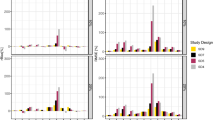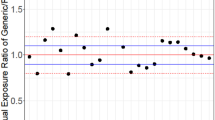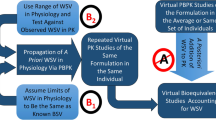Abstract
Purpose
Both inter-individual (IIV) and inter-occasion (IOV) variabilities are observed in bioequivalence studies. High IOV may be a cause of problems on the demonstration of bioequivalence, despite strict measures are taken to control it. The objective of this study is to investigate further means of controlling IIV by optimizing study design of crossover studies.
Methods
Data from 18 bioequivalence studies were used to develop population pharmacokinetics (popPK) models to characterize the absorption and disposition processes of 14 drugs, to estimate IOV for each drug substance and to evaluate possible correlations with biopharmaceutical properties of drug substances, classified in accordance to the Biopharmaceutics Drug Disposition Classification System (BDDCS).
Results
Plasma-pharmacokinetics profiles for the 14 drugs analyzed were successfully described using popPK. The pharmacokinetic parameters that showed greater variability were first-order rate constant of absorption, duration of the zero-order absorption process, relative bioavailability and time of latency. ISCV% estimated for Cmax seems to correlate with the log-Dose-Number for Class 1, 2 and 3, despite no direct correlation was observed between popPK model residual variability (RUV) and ISCV%. Nevertheless, higher RUV estimates were observed for Class 2 drugs in comparison to Class 1 and 3.
Conclusion
Pharmacokinetic parameters related to drug absorption showed greater variability.
Ingestion of the IMP along with 240 mL of water showed to standardize gastric emptying.
Given the dependency between Cmax variability and dose-solubility ratio, for classes 2 and 4, ad libitum water intake may increase Cmax and AUC ISCV%. A water ingestion standardization until the expected Tmax of the drug is suggested.




Similar content being viewed by others
References
Yu A, Sun D, Li BV, Lawrence XY. Bioequivalence history. FDA Bioequivalence standards: Springer; 2014. p. 1-27.
Amidon GL, Lennernas H, Shah VP, Crison JR. A theoretical basis for a biopharmaceutic drug classification: the correlation of in vitro drug product dissolution and in vivo bioavailability. Pharm Res. 1995;12(3):413–20.
Wu C-Y, Benet LZ. Predicting Drug Disposition via Application of BCS: Transport/Absorption/ Elimination Interplay and Development of a Biopharmaceutics Drug Disposition Classification System. Pharm Res. 2005;22(1):11–23.
European Medicines Agency (EMA). Guideline on the Investigation of Bioequivalence, Doc. Ref.: CPMP/EWP/QWP/1401/98 Rev. 1/ Corr., London, 20 January 2010 [Available from: http://www.ema.europa.eu/docs/en_GB/document_library/Scientific_guideline/2010/01/WC500070039.pdf.
Midha KK, McKay G. Bioequivalence; its history, practice, and future. AAPS J. 2009;11(4):664–70.
EMA. Guideline for good clinical practice E6 (R2) 2016 [Available from: https://www.ema.europa.eu/en/documents/scientific-guideline/ich-e-6-r2-guideline-good-clinical-practice-step-5_en.pdf.
Benet LZ, Broccatelli F, Oprea TI. BDDCS applied to over 900 drugs. AAPS J. 2011;13(4):519–47.
ChemAxon MarvinSketch User’s Guide. [Available from: https://docs.chemaxon.com/display/docs/MarvinSketch_User's_Guide.html.
Pires DEV, Blundell TL, Ascher DB (2015) pkCSM: Predicting small-molecule pharmacokinetic and toxicity properties using graph-based signatures. J Med Chem 58:4066–4072. [Available from: http://biosig.unimelb.edu.au/pkcsm/.
Ananchenko G, Novakovic J, Lewis J. Amlodipine besylate. Profiles of Drug Substances, Excipients and Related Methodology. 2012;37:31–77.
(FDA) USFaDA. PROZAC (fluoxetine) Label 1987 [Available from: https://www.accessdata.fda.gov/drugsatfda_docs/label/2017/018936s108lbl.pdf.
Johnson BM, Chang P-TL. Sertraline hydrochloride. Analytical Profiles of Drug Substances and Excipients. 24: Elsevier; 1996. p. 443-86.
(FDA) USFDA. SUTENT (sunitinib malate) Label 2006 [Available from: https://www.accessdata.fda.gov/drugsatfda_docs/label/2020/021938s037lbl.pdf.
Xeljanz® (Tofacitinib) FDA Clinical Pharmacology and Biopharmaceutics Review [Available from: https://www.accessdata.fda.gov/drugsatfda_docs/nda/2012/203214Orig1s000ClinPharmR.pdf.
ChemAxon - Software Solutions and Services for Chemistry & Biology [Available from: https://chemaxon.com/.
(FDA) USFaDA. Imbruvica (Ibrutinib) Label 2018 [Available from: https://www.accessdata.fda.gov/drugsatfda_docs/label/2020/205552s033,210563s010lbl.pdf.
Marzo A, Dal Bo L, Mazzucchellia P, Montia NC, Tettamantia RA, Crivellia F, et al. Pharmacokinetics and pharmacodynamics of zofenopril in healthy volunteers. Arzneimittel-Forschung. 1999;49(12):992–6.
(FDA) USFaDA. Duraclon (clonidine hydrochloride) injection, solution 2010 [Available from: https://www.accessdata.fda.gov/drugsatfda_docs/label/2010/020615s003lbl.pdf.
ALOGPS, Virtual Computational Chemistry Laboratory [Available from: http://www.vcclab.org/lab/alogps
Greenblatt DJ, Wright CE. Clinical pharmacokinetics of alprazolam. Clin Pharmacokinet. 1993;24(6):453–71.
(FDA) USFaDA. XANAX®(alprazolam) label 2021 [Available from: https://www.accessdata.fda.gov/drugsatfda_docs/label/2021/018276s058lbl.pdf.
Benet LZ, Broccatelli F, Oprea TI. BDDCS applied to over 900 drugs. The AAPS journal. 2011;13(4):519-47. Table IIb.Pharmacokinetic properties Click here to access/download;Table;Table IIb.Pharmacokinetic properties.pdf
(FDA) USFaDA. Norvasc (Amlodipine besylate) label 2017 [Available from: https://www.accessdata.fda.gov/drugsatfda_docs/label/2017/019787s062lbl.pdf.
Perez-Caballero L, Torres-Sanchez S, Bravo L, Mico JA, Berrocoso E. Fluoxetine: a case history of its discovery and preclinical development. Expert Opin Drug Discovery. 2014;9(5):567–78.
Altamura AC, Moro AR, Percudani M. Clinical pharmacokinetics of fluoxetine. Clin Pharmacokinet. 1994;26(3):201–14.
De Vane CL, Liston HL, Markowitz JS. Clinical pharmacokinetics of sertraline. Clin Pharmacokinet. 2002;41(15):1247–66.
Zoloft (sertraline hydrochloride)_biopharmr. 1998 [Available from: https://www.accessdata.fda.gov/drugsatfda_docs/nda/99/20990_Zoloft_biopharmr.pdf.
Haznedar JÖ, Patyna S, Bello CL, Peng GW, Speed W, Yu X, et al. Single-and multiple-dose disposition kinetics of sunitinib malate, a multitargeted receptor tyrosine kinase inhibitor: comparative plasma kinetics in non-clinical species. Cancer Chemother Pharmacol. 2009;64(4):691–706.
Speed B, Bu H-Z, Pool WF, Peng GW, Wu EY, Patyna S, et al. Pharmacokinetics, distribution, and metabolism of [14C] sunitinib in rats, monkeys, and humans. Drug Metab Dispos. 2012;40(3):539–55.
Arcoxia 120 mg Film-coated Tablets SmPC, Last revised version, MAY2021 [Available from: https://www.medicines.org.uk/emc/product/10618/smpc.
Febuxostat_Adenuric SmPC [Available from: https://www.medicines.org.uk/emc/product/1925/smpc#gref.
Mylan. Zofenopril Mylan film-coated tablet ENG SmPC [Available from: https://mri.ctsmrpeu/human/downloads/PT_H_1446_001_FinalPI_1of4.pdf.
Catapres®. Prescribing Information. Last revised version, MAY2015 2009 [Available from: https://www.accessdata.fda.gov/drugsatfda_docs/label/2012/017407s037lbl.pdf.
Niemeyer C, Hasenfuss G, Wais U, Knauf H, Schäfer-Korting M, Mutschler E. Pharmacokinetics of hydrochlorothiazide in relation to renal function. Eur J Clin Pharmacol. 1983;24(5):661–5.
FDA Approved Drug Products: Hydrochlorothiazide Oral Capsules [Available from: https://www.accessdata.fda.gov/drugsatfda_docs/label/2011/020504s018lbl.pdf.
Avelox®. Prescribing Information. Last revised version, JUL2016 [Available from: https://www.merck.com/product/usa/pi_circulars/a/avelox/avelox_pi.pdf.
(FDA) USFaDA. AVELOX (moxifloxacin hydrochloride) Label 1999 [Available from: https://www.accessdata.fda.gov/drugsatfda_docs/label/2016/021085s063lbl.pdf.
Hylaton 50mg Tablets - Summary of Product Characteristics (SmPC)
Collste P, Garle M, Rawlins M, Sjöqvist F. Interindividual differences in chlorthalidone concentration in plasma and red cells of man after single and multiple doses. Eur J Clin Pharmacol. 1976;9(4):319–25.
Mould DR, Upton RN. Basic concepts in population modeling, simulation, and model-based drug development-part 2: introduction to pharmacokinetic modeling methods. CPT Pharmacometrics Syst Pharmacol. 2013;2:e38.
Upton RN, Mould DR. Basic concepts in population modeling, simulation, and model-based drug development: part 3-introduction to pharmacodynamic modeling methods. CPT Pharmacometrics Syst Pharmacol. 2014;3:e88.
FDA. FDA Guidance for Industry: Population Pharmacokinetics. U.S. Department of Health and Human Services Food and Drug Administration 1999 [Available from: https://www.fda.gov/downloads/drugs/guidances/UCM072137.pdf.
Faulkner J, McGibney D, Chasseaud L, Perry J, Taylor I. The pharmacokinetics of amlodipine in healthy volunteers after single intravenous and oral doses and after 14 repeated oral doses given once daily. Br J Clin Pharmacol. 1986;22(1):21–5.
Meredith PA, Elliott HL. Clinical pharmacokinetics of amlodipine. Clin Pharmacokinet. 1992;22(1):22–31.
(FDA) USFaDA. XELJANZ (tofacitinib) Label 2012 [Available from: https://www.accessdata.fda.gov/drugsatfda_docs/nda/2012/203214Orig1s000ClinPharmR.pdf.
Agrawal NG, Porras AG, Matthews CZ, Rose MJ, Woolf EJ, Musser BJ, et al. Single-and multiple-dose pharmacokinetics of etoricoxib, a selective inhibitor of cyclooxygenase-2, in man. J Clin Pharmacol. 2003;43(3):268–76.
(FDA) USFaDA. Uloric (febuxostat) tablet for oral use 2009 [Available from: https://www.accessdata.fda.gov/drugsatfda_docs/nda/2009/021856s000_ClinPharmR_P2.pdf. s037lbl.pdf.
Dressman J, Amidon G, Fleisher D. Absorption potential: estimating the fraction absorbed for orally administered compounds. J Pharm Sci. 1985;74(5):588–9.
Shum B, Duffull S, Taylor P, Tett S. Population pharmacokinetic analysis of mycophenolic acid in renal transplant recipients following oral administration of mycophenolate mofetil. Br J Clin Pharmacol. 2003;56(2):188–97.
Chryssafidis P, Tsekouras AA, Macheras P. Revising Pharmacokinetics of Oral Drug Absorption: II Bioavailability-Bioequivalence Considerations. Pharm Res. 2021:1–12.
Macheras P, Chryssafidis P. Revising Pharmacokinetics of Oral Drug Absorption: I Models Based on Biopharmaceutical/Physiological and Finite Absorption Time Concepts. Pharm Res. 2020;37(10):1–13.
Rinaki E, Valsami G, Macheras P. Quantitative biopharmaceutics classification system: The central role of dose/solubility ratio. Pharm Res. 2003;20(12):1917–25.
Rinaki E, Dokoumetzidis A, Macheras P. The mean dissolution time depends on the dose/solubility ratio. Pharm Res. 2003;20(3):406–8.
Charkoftaki G, Dokoumetzidis A, Valsami G, Macheras P. Elucidating the role of dose in the biopharmaceutics classification of drugs: the concepts of critical dose, effective in vivo solubility, and dose-dependent BCS. Pharm Res. 2012;29(11):3188–98.
Charalabidis A, Sfouni M, Bergström C, Macheras P. The biopharmaceutics classification system (BCS) and the biopharmaceutics drug disposition classification system (BDDCS): beyond guidelines. Int J Pharm. 2019;566:264–81.
Macheras PE, Symillides MY. Toward a quantitative approach for the prediction of the fraction of dose absorbed using the absorption potential concept. Biopharm Drug Dispos. 1989;10(1):43–53.
Romanski KW. Importance of the enteric nervous system in the control of the migrating motility complex. Physiol Int. 2017;104(2):97–129.
Deloose E, Janssen P, Depoortere I, Tack J. The migrating motor complex: control mechanisms and its role in health and disease. Nat Rev Gastroenterol Hepatol. 2012;9(5):271.
Code CF, Marlett JA. The interdigestive myo-electric complex of the stomach and small bowel of dogs. J Physiol. 1975;246(2):289–309.
Administration F-USDoHaHSFaD, (CDER) CfDEaR. Bioequivalence Studies with Pharmacokinetic Endpoints for Drugs Submitted Under an ANDA-Guidance for Industry 2013 [Available from: https://www.fda.gov/downloads/drugs/guidances/ucm377465.pdf.
Kim KA, Park PW, Park JY. Effect of ABCB1 (MDR1) haplotypes derived from G2677T/C3435T on the pharmacokinetics of amlodipine in healthy subjects. Br J Clin Pharmacol. 2007;63(1):53–8.
Katoh M, Nakajima M, Yamazaki H, Yokoi T. Inhibitory potencies of 1, 4-dihydropyridine calcium antagonists to P-glycoprotein-mediated transport: comparison with the effects on CYP3A4. Pharm Res. 2000;17(10):1189–97.
O'Brien FE, Dinan TG, Griffin BT, Cryan JF. Interactions between antidepressants and P-glycoprotein at the blood–brain barrier: clinical significance of in vitro and in vivo findings. Br J Pharmacol. 2012;165(2):289–312.
Weiss J, Dormann S-MG, Martin-Facklam M, Kerpen CJ, Ketabi-Kiyanvash N, Haefeli WE. Inhibition of P-glycoprotein by newer antidepressants. J Pharmacol Exp Ther. 2003;305(1):197–204.
Boxberger KH, Hagenbuch B, Lampe JN. Ligand-dependent modulation of hOCT1 transport reveals discrete ligand binding sites within the substrate translocation channel. Biochem Pharmacol. 2018;156:371–84.
Finch A, Pillans P. P-glycoprotein and its role in drug-drug interactions. Aust Prescr. 2014;37(4):137–9.
Kapoor A, Iqbal M, Petropoulos S, Ho HL, Gibb W, Matthews SG. Effects of sertraline and fluoxetine on p-glycoprotein at barrier sites: in vivo and in vitro approaches. PLoS One. 2013;8(2):e56525.
Feng S, Zheng L, Tang S, Gu J, Jiang X, Wang L. In-vitro and in situ assessment of the efflux of five antidepressants by breast cancer resistance protein. J Pharm Pharmacol. 2019;71(7):1133–41.
Tang SC, Lagas JS, Lankheet NA, Poller B, Hillebrand MJ, Rosing H, et al. Brain accumulation of sunitinib is restricted by P-glycoprotein (ABCB1) and breast cancer resistance protein (ABCG2) and can be enhanced by oral elacridar and sunitinib coadministration. Int J Cancer. 2012;130(1):223–33.
Shukla S, Robey RW, Bates SE, Ambudkar SV. Sunitinib (Sutent, SU11248), a small-molecule receptor tyrosine kinase inhibitor, blocks function of the ATP-binding cassette (ABC) transporters P-glycoprotein (ABCB1) and ABCG2. Drug Metab Dispos. 2009;37(2):359–65.
Hu S, Chen Z, Franke R, Orwick S, Zhao M, Rudek MA, et al. Interaction of the multikinase inhibitors sorafenib and sunitinib with solute carriers and ATP-binding cassette transporters. Clin Cancer Res. 2009;15(19):6062–9.
Gao Y-l, He B. ABCB1 1199G> A Polymorphism Affects the Intracellular Accumulation of Antidepressants in LLC-PK1 Recombinant Cell Lines. DNA Cell Biol. 2018;37(12):1055–60.
Poller B, Wagenaar E, Tang SC, Schinkel AH. Double-transduced MDCKII cells to study Human P-glycoprotein (ABCB1) and breast cancer resistance protein (ABCG2) interplay in drug transport across the blood− brain barrier. Mol Pharm. 2011;8(2):571–82.
Benet LZ. The role of BCS (biopharmaceutics classification system) and BDDCS (biopharmaceutics drug disposition classification system) in drug development. J Pharm Sci. 2013;102(1):34–42.
Wu X, Huang W, Ganapathy ME, Wang H, Kekuda R, Conway SJ, et al. Structure, function, and regional distribution of the organic cation transporter OCT3 in the kidney. American Journal of Physiology-Renal Physiology. 2000;279(3):F449–F58.
Yabuuchi H, Tamai I, Nezu J-I, Sakamoto K, Oku A, Shimane M, et al. Novel membrane transporter OCTN1 mediates multispecific, bidirectional, and pH-dependent transport of organic cations. J Pharmacol Exp Ther. 1999;289(2):768–73.
Hasegawa M, Kusuhara H, Adachi M, Schuetz JD, Takeuchi K, Sugiyama Y. Multidrug resistance–associated protein 4 is involved in the urinary excretion of hydrochlorothiazide and furosemide. J Am Soc Nephrol. 2007;18(1):37–45.
Race JE, Grassl SM, Williams WJ, Holtzman EJ. Molecular cloning and characterization of two novel human renal organic anion transporters (hOAT1 and hOAT3). Biochem Biophys Res Commun. 1999;255(2):508–14.
EMA. Guideline on the Investigation of Bioequivalence 2010 [Available from: http://www.ema.europa.eu/docs/en_GB/document_library/Scientific_guideline/2010/01/WC500070039.pdf.
Conflict of Interest statement
We have no conflicts of interest to disclose.
Funding
The principal author is it supported by a University of Porto and FSE – Fundo Social Europeu, by doctoral scholarship of NORTE2020- Programa Operacional Regional do Norte-08-5369-FSE-000011.
Author information
Authors and Affiliations
Corresponding author
Additional information
Publisher’s Note
Springer Nature remains neutral with regard to jurisdictional claims in published maps and institutional affiliations.
Supplementary Information
ESM 1
(PDF 108 kb)
Rights and permissions
About this article
Cite this article
Ameijeiras Rodríguez, C., Henriques, S.C., Sancho-Araiz, A. et al. Untangling Absorption Mechanisms and Variability in Bioequivalence Studies Using Population Analysis. Pharm Res 38, 2047–2063 (2021). https://doi.org/10.1007/s11095-021-03136-3
Received:
Accepted:
Published:
Issue Date:
DOI: https://doi.org/10.1007/s11095-021-03136-3




